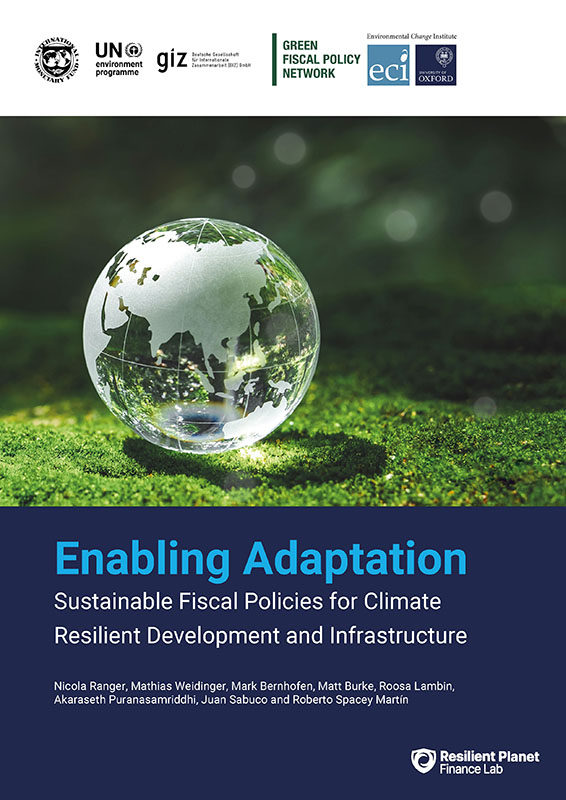Effective fiscal policies are crucial for closing the financing and resilience gap in infrastructure adaptation, particularly for countries facing fiscal constraints. Here Dr Nicola Ranger discusses the key roles fiscal policies can play in building resilience and catalysing resilience investment.
Investment in adaptation and growth have historically been pitched as trade-offs, yet the evidence is clear that adaptation is not only a cost-effective use of public funds, but also vital to underpin prosperity, wellbeing and economic security.
A new report, produced by the Global Finance and Economy Group at ECI in partnership with the UN Environment Programme (UNEP), with support from the Green Fiscal Policy Network and the FCDO Climate Compatible Growth Programme, provides new evidence on the fiscal case for adaptation and lays out how governments can maximise the efficiency of public expenditure in this sector, focusing on four areas:
- Integrating adaptation into fiscal risk management and financing strategies,
- Aligning public spending with climate resilience goals,
- Maximising the effectiveness of public finance through effective policy frameworks to mobilise private investment in adaptation,
- Investing in data as a public good to support resilient development.
Infrastructure is one of the most urgent areas for adaptation and a focus of the report. Additional annual infrastructure investments of well over $1 trillion are needed until 2040 to achieve the SDGs, with more than 70% in emerging and developing economies (EMDEs). It is vital that new and existing infrastructure is resilient; according to the World Bank, disruption to infrastructure is already estimated to cost at least $390 billion a year across EMDEs. Yet, the extra cost of building resilience into these systems is only 3 percent of overall investment needs versus an overall net benefit of $4.2 trillion.

So, what role can effective fiscal policy play in closing the financing and resilience gap, particularly for countries facing fiscal constraints?
Firstly, we highlight that building resilience is not just about hard investments – like sea walls – it requires effective fiscal and wider policies designed to absorb shocks when they occur and ensure countries can bounce back and recover quickly, so avoiding long-term impacts on people and economic progress. As one example, the report demonstrates the fiscal benefits of insurance in protecting not just livelihoods but also fiscal budgets and debt sustainability.
The report also presents clear evidence of the false dichotomy between debt sustainability, growth and investment in adaptation. Several countries note the difficulties of investing in adaptation given fiscal constraints and debt ceilings. Analyses presented in this report demonstrate the benefits of adaptation for debt sustainability. However, we also find that debt sustainability analyses currently do not fully account for physical climate risks and where adaptation is included, this is simplistic. We argue for a more thorough treatment of physical risks and adaptation within debt sustainability analyses, and exploration of the potential for a cost of capital reduction in sovereign financing where this is linked to adaptation (e.g. ‘adaptation-linked sovereign bonds’).
Secondly, we demonstrate how the alignment of fiscal policies and adaptation is essential for resilient development and leads to more effective use of public funds. Despite the fiscal win-wins of adaptation, previous analyses have shown that only a relatively small fraction of fiscal expenditure is aligned with adaptation and resilience goals, and further that there is evidence that a large portion of fiscal expenditure may be inefficient in locking societies into greater long-term risks. New analyses shown in this report demonstrates that the same holds true for natural capital investments, which are an important part of adaptation and infrastructure investments. The report argues for greater integration of resilience and nature within sustainable budgeting approaches, project procurement and appraisal, and highlights the role of taxonomies in this respect, as well as the opportunities to leverage existing standards and frameworks.
Thirdly, the report demonstrates how public finance can go further through an effective use of expenditure and policies to mobilise for private capital. This includes but goes beyond blended finance. For example, the report cites Rwanda as an example how clear national targets, governance frameworks and innovative sovereign financing can enable adaptation and transition finance. Finally, it stresses the role of public and private sector in providing data for adaptation as a public good, essential for catalysing resilient investment and informed decision-making.
Read the report in full: Enabling Adaptation: Sustainable Fiscal Policies for Climate Resilient Development (2025)
